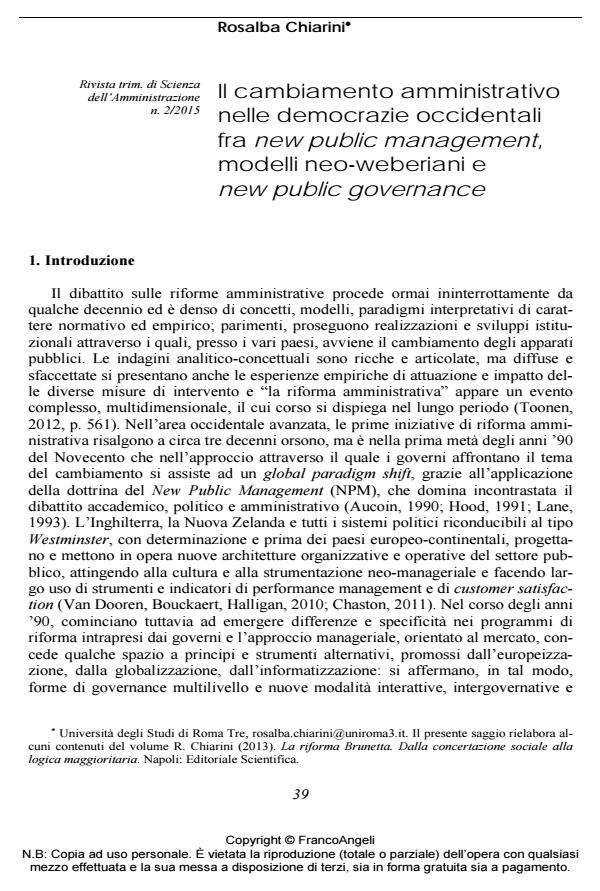Il cambiamento amministrativo nelle democrazie occidentali fra new public management, modelli neo-weberiani e new public governance
Titolo Rivista RIVISTA TRIMESTRALE DI SCIENZA DELL’AMMINISTRAZIONE
Autori/Curatori Rosalba Chiarini
Anno di pubblicazione 2015 Fascicolo 2015/2
Lingua Italiano Numero pagine 16 P. 39-54 Dimensione file 90 KB
DOI 10.3280/SA2015-002003
Il DOI è il codice a barre della proprietà intellettuale: per saperne di più
clicca qui
Qui sotto puoi vedere in anteprima la prima pagina di questo articolo.
Se questo articolo ti interessa, lo puoi acquistare (e scaricare in formato pdf) seguendo le facili indicazioni per acquistare il download credit. Acquista Download Credits per scaricare questo Articolo in formato PDF

FrancoAngeli è membro della Publishers International Linking Association, Inc (PILA)associazione indipendente e non profit per facilitare (attraverso i servizi tecnologici implementati da CrossRef.org) l’accesso degli studiosi ai contenuti digitali nelle pubblicazioni professionali e scientifiche
L’articolo ricostruisce il dibattito sulle riforme amministrative e parimenti dà conto delle realizzazioni attraverso le quali, presso i vari paesi, è avvenuto e procede il cambiamento degli apparati pubblici. Nell’area occidentale avanzata, fin dagli anni ’80 del Novecento, la dottrina del New Public Management ha ispirato nuove architetture organizzative e operative del settore pubblico, attingendo alla cultura e alla strumentazione neo-manageriale, nonché ad indicatori di performance management. Nel corso degli anni ’90, sono emerse tuttavia delle specificità nei programmi di riforma e nuovi principi hanno affiancato l’approccio manageriale orientato al mercato, quali forme di governance multilivello e nuove modalità interattive, intergovernative e cooperative di public management, o lo sviluppo di formule di partnership pubblico-privato e di forme ibride nelle relazioni fra Stato, società e mercati. L’ultima sezione dell’articolo è dedicata alle trasformazioni della funzione manageriale nel settore pubblico italiano, le quali corrono fra il principio di distinzione con la sfera politica e l’introduzione di elementi di fiduciarietà.
Parole chiave:Riforma amministrativa, managerialismo pubblico, rapporto tra politica e amministrazione
Rosalba Chiarini, Il cambiamento amministrativo nelle democrazie occidentali fra new public management, modelli neo-weberiani e new public governance in "RIVISTA TRIMESTRALE DI SCIENZA DELL’AMMINISTRAZIONE" 2/2015, pp 39-54, DOI: 10.3280/SA2015-002003